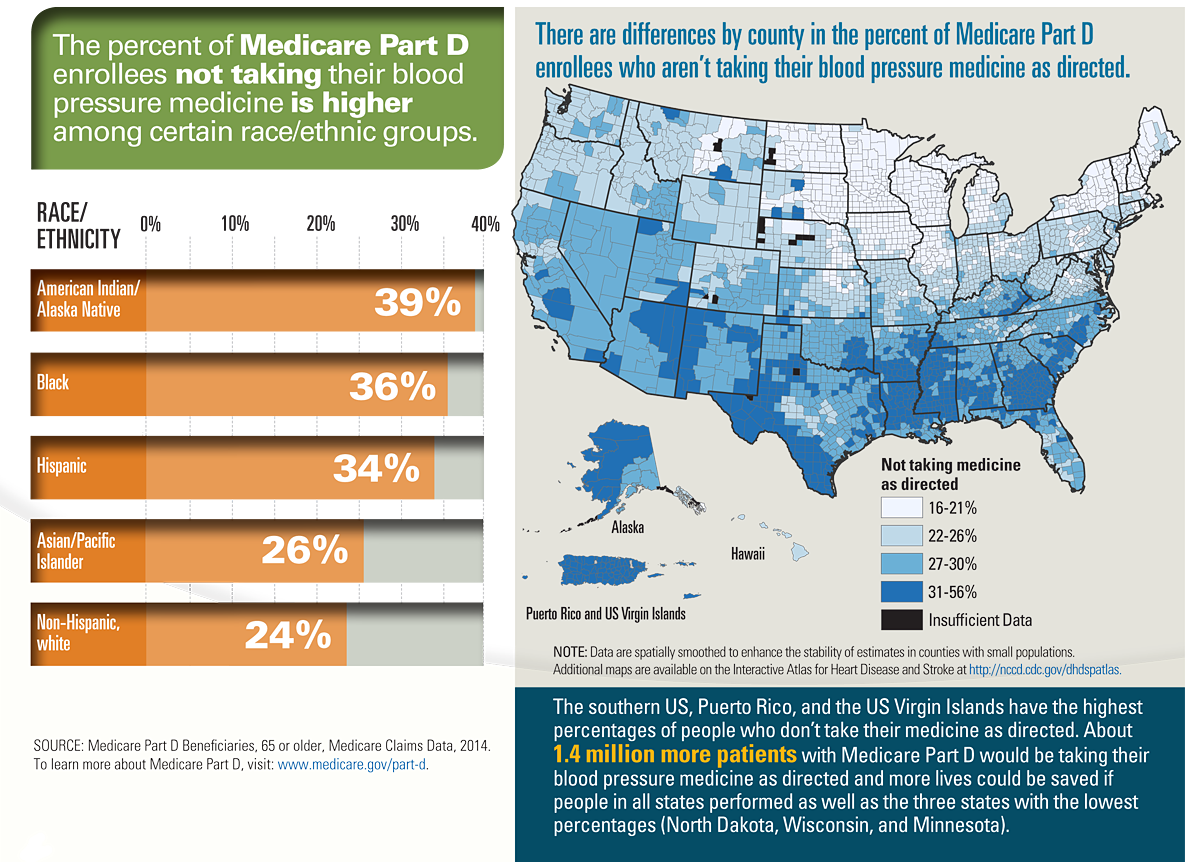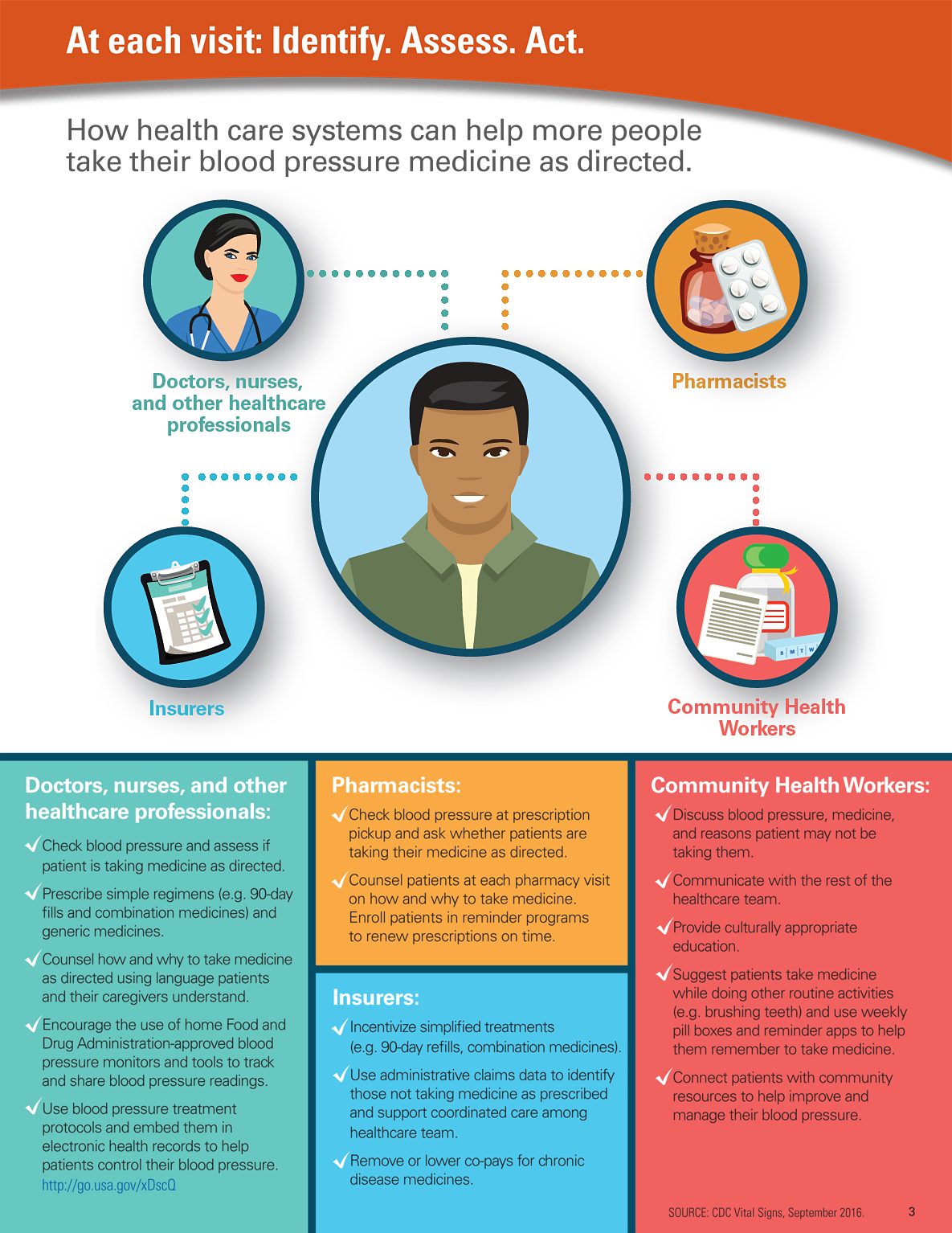Blood Pressure Control
Helping Patients Take Their Medicine.
On the left side, there is a horizontal bar graph representing how the percent of Medicare Part D enrollees not taking their blood pressure medicine is higher among certain race/ethnic groups.
The “Race/Ethnicity” percentages are:
| Race/Ethnicity | Percentage % |
|---|---|
| American Indian/Alaska Native | 39% |
| Black | 36% |
| Hispanic | 34% |
| Asian/Pacific Islander | 26% |
| Non-Hispanic, white | 24% |
SOURCE: Medicare Part D Beneficiaries, 65 or older, Medicare Claims Data, 2014.
To learn more about Medicare Part D, visit: www.medicare.gov/part-d.
On the right side, there is a map of the United States representing the differences by county in the percent of Medicare Part D enrollees who aren’t taking their blood pressure medicine as directed.
The map breaks down the variable of “Not taking medicine as directed” using the following groupings for counties:
16-21%
22-26%
27-30%
31-56%
Insufficient Data
Note: Data are spatially smoothed to enhance the stability of estimates in counties with small populations.
Additional maps are available on the Interactive Atlas for Heart Disease and Stroke at http://nccd.cdc.gov/dhdspatlas
The southern United States, Puerto Rico, and the U.S. Virgin Islands have the highest percentages of people who don’t take their medicine as directed. About 1.4 million more patients with Medicare Part D would be taking their blood pressure medicine as directed and more lives could be saved if people in all states performed as well as the three states with the lowest percentages (North Dakota, Wisconsin, and Minnesota).
| State | Not taking medicine as directed (%) |
|---|---|
| Alabama | 29.9 |
| Alaska | 29.0 |
| Arizona | 28.2 |
| Arkansas | 30.4 |
| California | 27.1 |
| Colorado | 26.3 |
| Connecticut | 23.1 |
| Delaware | 23.0 |
| District of Columbia | 33.7 |
| Florida | 27.7 |
| Georgia | 31.0 |
| Hawaii | 25.5 |
| Idaho | 25.2 |
| Illinois | 23.8 |
| Indiana | 23.9 |
| Iowa | 19.7 |
| Kansas | 25.0 |
| Kentucky | 27.7 |
| Louisiana | 31.5 |
| Maine | 20.7 |
| Maryland | 25.4 |
| Massachusetts | 21.9 |
| Michigan | 23.3 |
| Minnesota | 18.9 |
| Mississippi | 32.8 |
| Missouri | 25.3 |
| Montana | 23.3 |
| Nebraska | 22.6 |
| Nevada | 28.2 |
| New Hampshire | 20.5 |
| New Jersey | 25.3 |
| New Mexico | 29.8 |
| New York | 25.3 |
| North Carolina | 28.1 |
| North Dakota | 18.7 |
| Ohio | 23.9 |
| Oklahoma | 29.6 |
| Oregon | 23.9 |
| Pennsylvania | 24.0 |
| Puerto Rico | 39.6 |
| Rhode Island | 22.9 |
| South Carolina | 29.6 |
| South Dakota | 21.0 |
| Tennessee | 28.0 |
| Texas | 30.8 |
| U.S. Virgin Islands | 46.9 |
| Utah | 28.7 |
| Vermont | 19.1 |
| Virginia | 25.7 |
| Washington | 24.1 |
| West Virginia | 25.8 |
| Wisconsin | 18.8 |
| Wyoming | 25.5 |
The infographic is titled, “At each visit: Identify. Assess. Act.”
This page describes how health care systems can help more people take their blood pressure medicine as directed.
In the illustration, there is an image of a man at the center. Four branches extend from the center, which include 1) “doctors, nurses, and other healthcare professionals” depicted by an illustration of a nurse, 2) “pharmacists” depicted by an illustration of a pill bottle and pill pack, 3) “insurers” depicted by an illustration of a checklist on a clipboard, and 4) “community health workers” depicted by an illustration of a pill bottle, weekly pill box, and a piece of paper
Doctors, nurses, and other healthcare professionals are advised to:
- Check blood pressure and assess if patient is taking medicine as directed.
- Prescribe simple regimens (e.g. 90-day fills and combination medicines) and generic medicines.
- Counsel how and why to take medicine as directed using language patients and their caregivers understand.
- Encourage the use of home Food and Drug Administration-approved blood pressure monitors and tools to track and share blood pressure readings.
- Use blood pressure treatment protocols and embed them in electronic health records to help patients control their blood pressure. http://go.usa.gov/xDscQ
Pharmacists are advised to:
- Check blood pressure at prescription pickup and ask whether patients are taking their medicine as directed.
- Counsel patients at each pharmacy visit on how and why to take medicine. Enroll patients in reminder programs to renew prescriptions on time.
Insurers are advised to:
- Incentivize simplified treatments (e.g. 90-day refills, combination medicines).
- Use administrative claims data to identify those not taking medicine as prescribed and support coordinated care among healthcare team.
- Remove or lower co-pays for chronic disease medicines.
Community Health Workers are advised to:
- Discuss blood pressure, medicine, and reasons patient may not be taking them.
- Communicate with the rest of the healthcare team.
- Provide culturally appropriate education.
- Suggest patients take medicine while doing other routine activities (e.g. brushing teeth) and use weekly pill boxes and reminder apps to help them remember to take medicine.
- Connect patients with community resources to help improve and manage their blood pressure.
SOURCE: CDC Vital Signs, September 2016.
- Page last reviewed: September 13, 2016
- Page last updated: September 13, 2016
- Content source:
- National Center for Chronic Disease Prevention and Health Promotion
- Page maintained by: Office of the Associate Director for Communications (OADC)


 ShareCompartir
ShareCompartir

